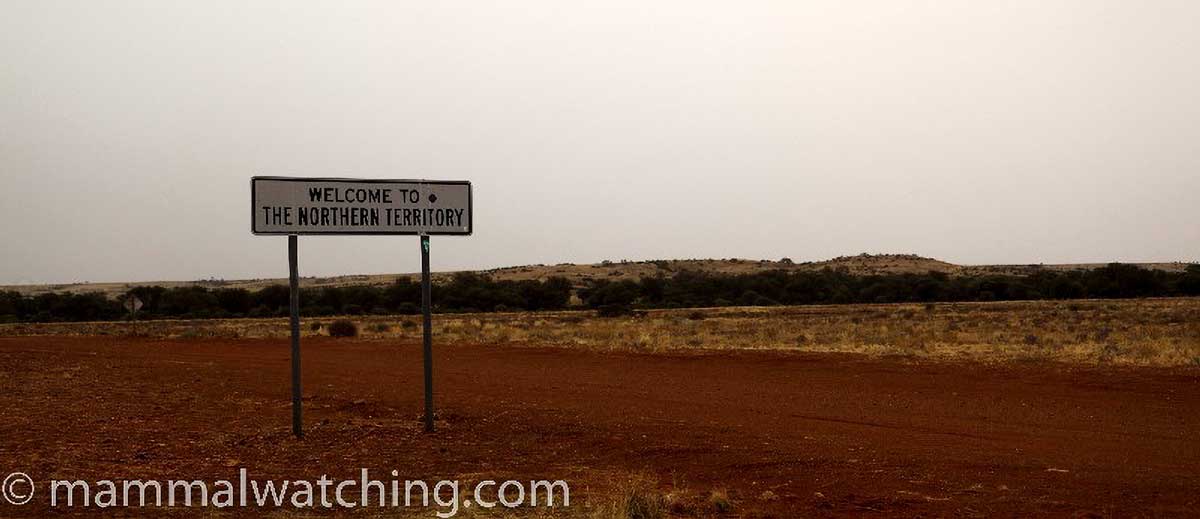
Northern Territory
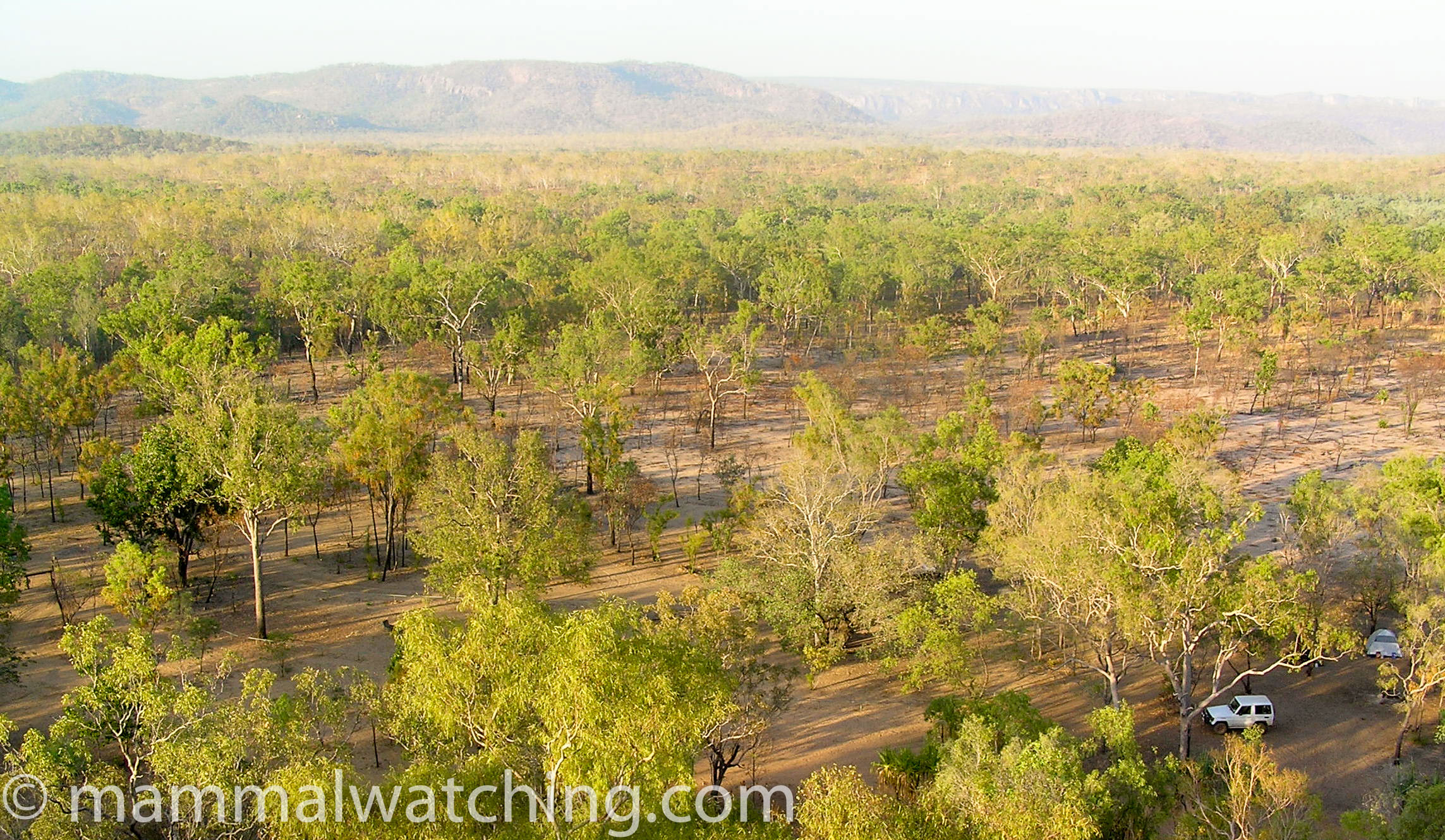
Kakadu National Park
The Northern Territory is big, hot and for the most part empty of people. A good portion of the woodland across the top half of the territory burns each dry season, and spends months underwater during the wet. The bottom half is mainly desert. The NT has what I guess are Australia’s two most famous national parks – Uluru (formerly know as Ayers Rock), in the south of the state, and Kakadu in the north. And the Territory is home to an impressive set of mammals, some of which are among the hardest species to find in Australia.
Darwin Area
Whenever I land at Darwin I feel like I’ve left Australia and arrived in a foreign land. For one thing, it is invariably hotter and more humid than wherever I’ve flown in from. And, for another, the locals are exotic, even by northern Australian standards: its all tattoos, Harley Davidsons and chest length beards. And that’s just the women.
Fogg Dam, close to Darwin, is an excellent mammal watching spot and well known among bird watchers. The interpretive signs there say something along the lines that – I think – the reserve’s large population of Water Pythons, which feed on the larger population of Dusky Rats (Rattus colletti) give the swamp the highest biomass of any place on earth. The Pythons are easy to see. I have spent several nights spotlighting at the dam during various seasons and always see them sliding across the main road – the causeway – that runs through the park.
The Dusky Rats are harder to find. I eventually found one in May after my third or fourth visit: it was sitting on the causeway one evening. They are probably easiest to find in the wet season (the population peaks then I think), though I was pretty unlucky not to see one when I did a bit of trapping there one May evening.
Spotlighting along the causeway, and some of the short trails can also be very good, though the mosquitoes can be shocking both in terms of their size and abundance. I remember a particularly unpleasant evening camping nearby when the mozzies were biting me through the mosquito net of my swag. Other animals I’ve seen at Fogg Dam include what I think was my one and only Red-cheeked Dunnart, on the edge of the receding water in a paperbark swamp (Red cheeked Dunnarts are often found on the margins of soaks as they are drying out) though I saw it so poorly I didn’t tick it, Water Rats, Northern (Least) Blossom Bats (you can pick up their eyeshine), along with Agile Wallabies and a couple of Common Planigales that I caught in Elliott traps. Black Flying Foxes are pretty common there too.
There are several other good spots around Darwin where various critters can turn up. Australian Snubfin Dolphins (recently split from the Irrawaddy Dolphin) are often seen in some of the estuaries around town (though I have never seen them). Northern Brushtail Possums lurk in the mangroves, while Northern Mastiff Bats (I was reliably informed) roost under the main pier in Darwin. I could hear them squeaking but couldn’t see the animals in August 2005. There is also a colony of Northern Bentwing Bats (Miniopterus oceanesis orianae) in a culvert along Lakeview Drive, near to the University.
Black-footed Tree Rats, Brushtail Possums and Northern Brown Bandicoots are reasonably common in the woodland out of town (as were Northern Quolls a few years ago). I also saw Brushtail Possums at Howard Springs (some, but not me, split the NT Brushtail Possums as a separate species, Trichosurus arnhemensis).
In 2005 Damian Milne from the Parks and Wildlife Service took me bat trapping. We stuck up a couple of harp traps out at Holmes Jungle Swamp (near Darwin Airport). In two nights we caught both Northern and Pygmy Long-eared Bats and Northern (Mangrove) Pipistrelle, a rather strange looking Gould’s Wattled Bat, a Northern Bentwing (Miniopterus oceansis orianae), and scores of Broadnosed Bats (either Scotorepens sanborni or greyii).
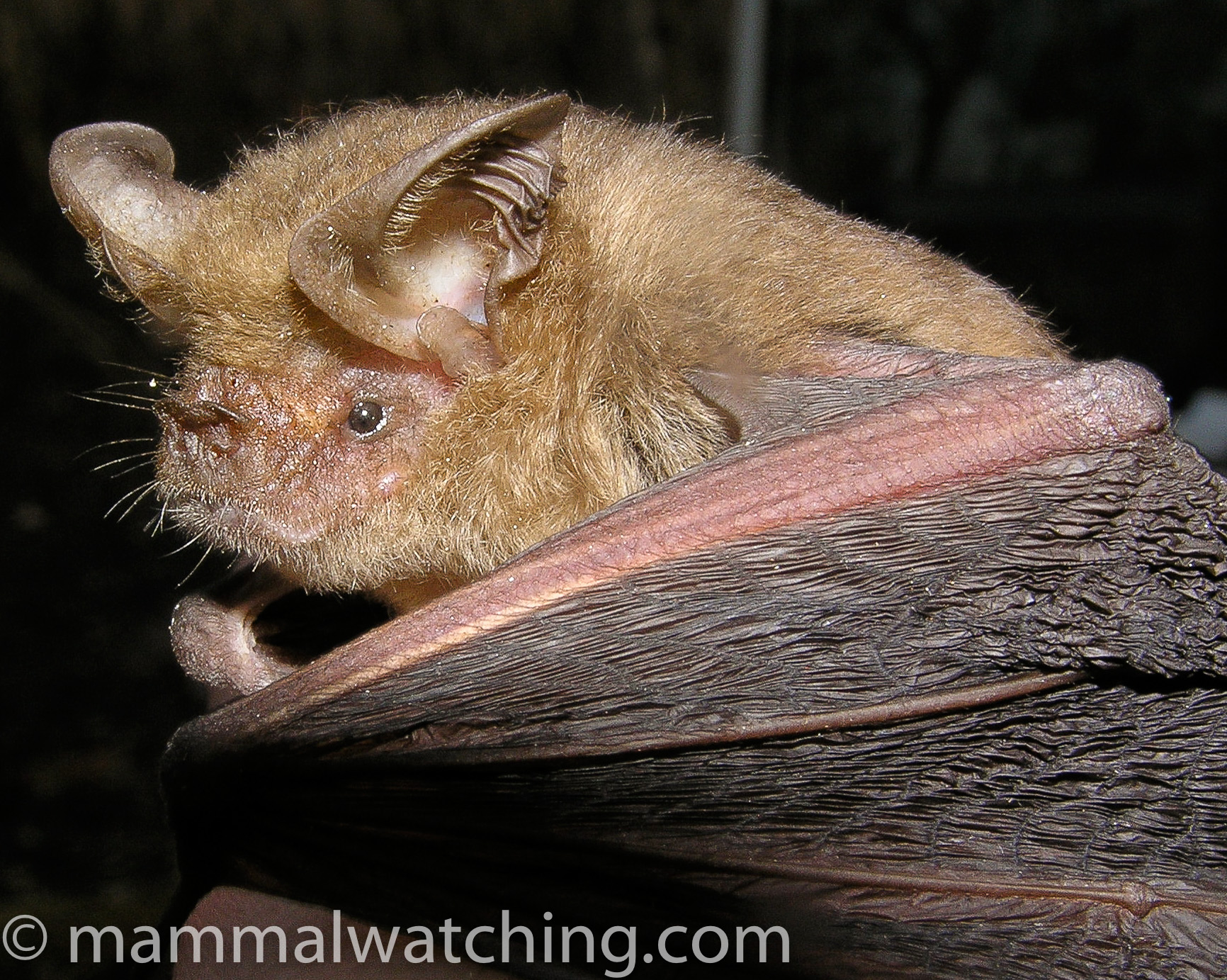
Arnhem Longeared Bat, Nyctophilus arnhemensis
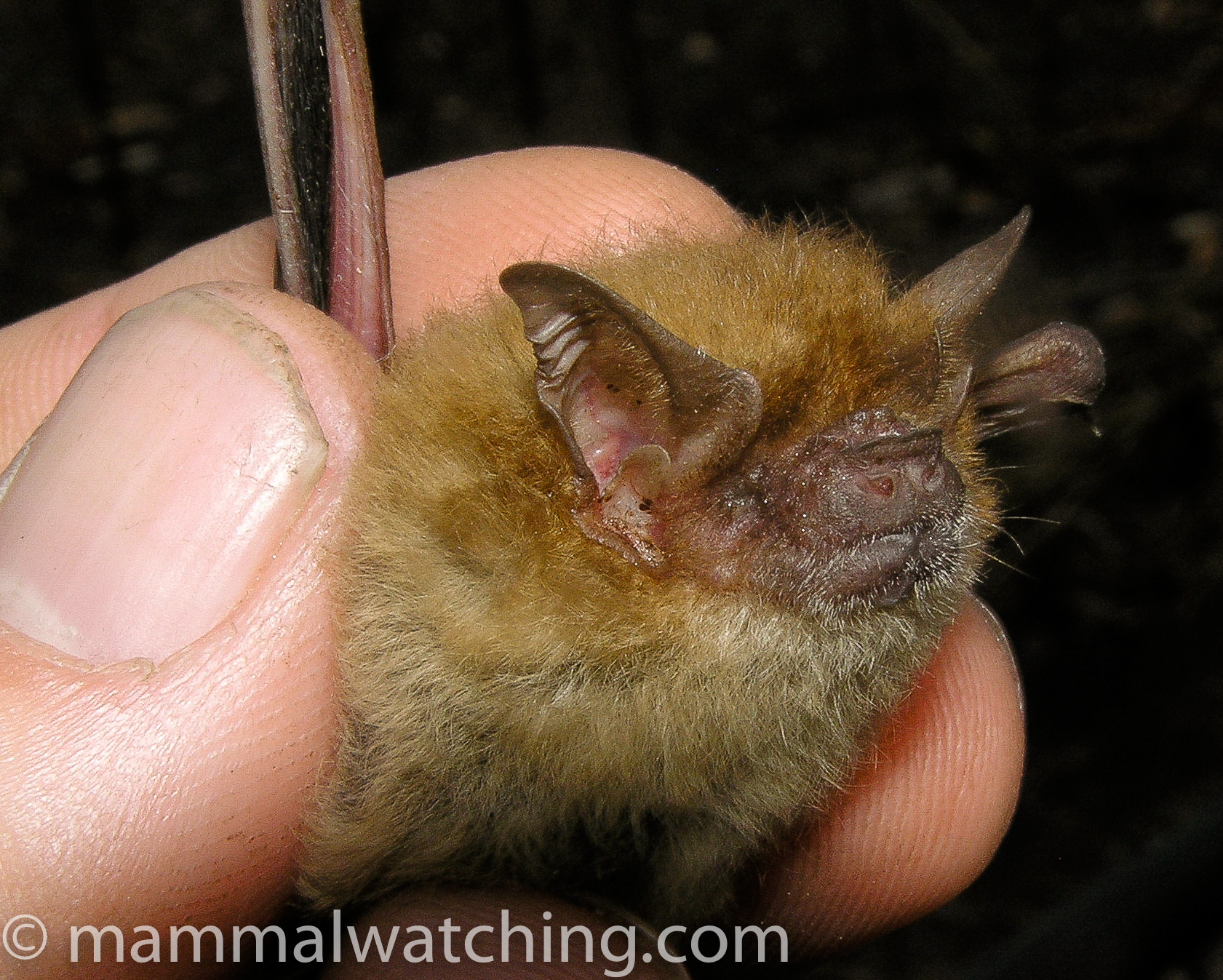
Pygmy Longeared Bat, Nyctophilus walkeri
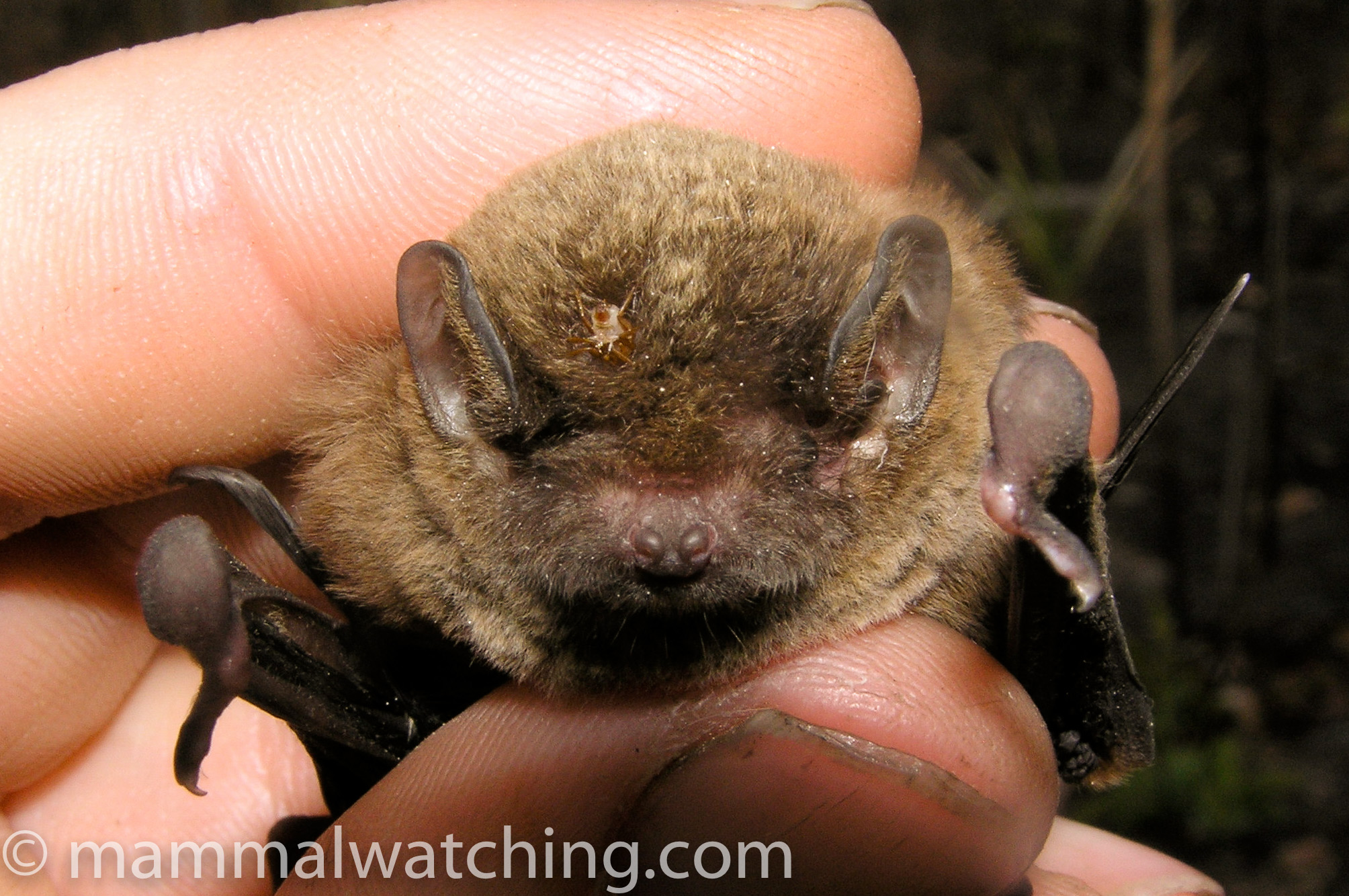
Northern Pipistrelle, Pipistrellus westralis
Kakadu National Park
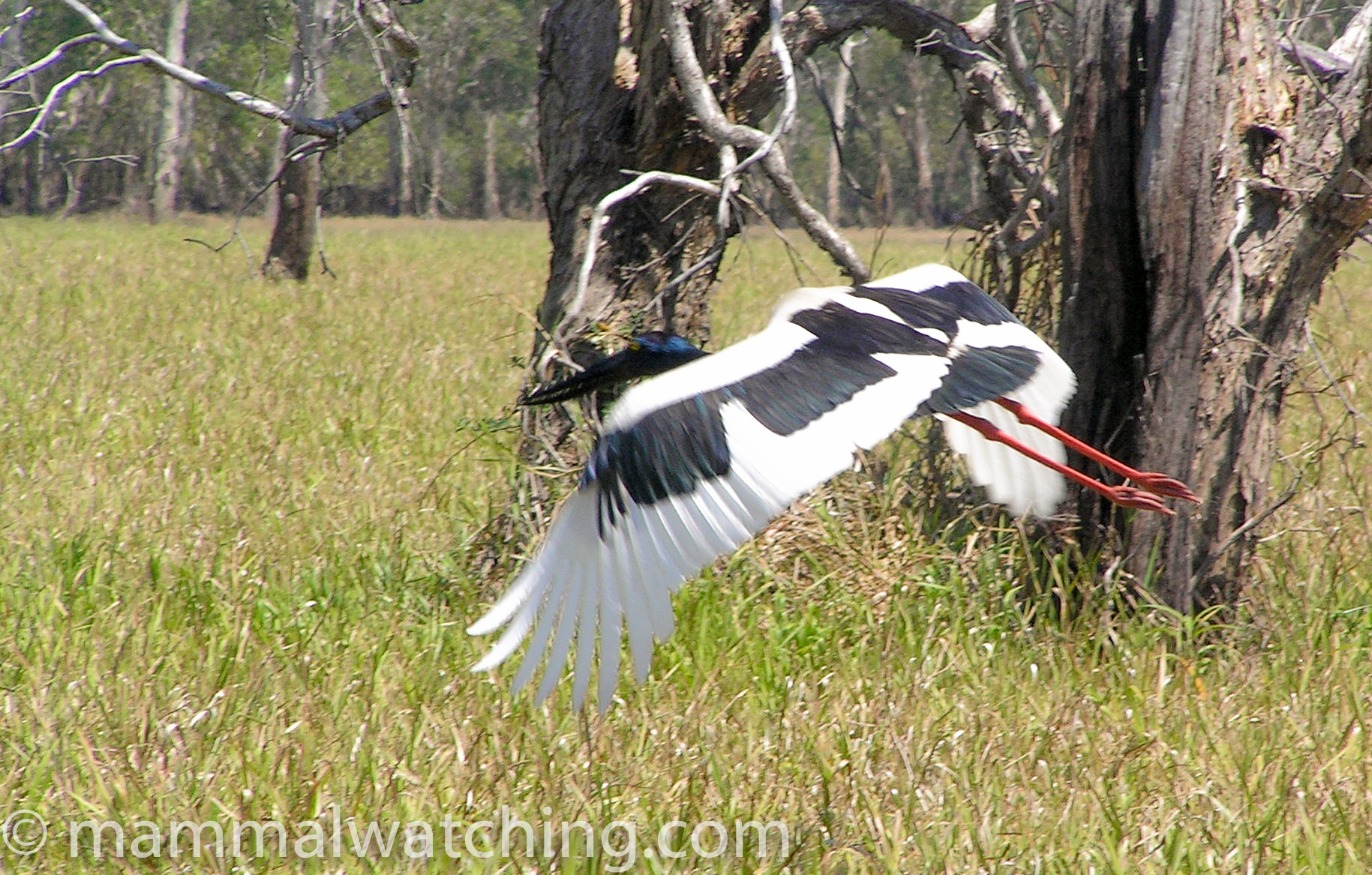
Jabiru, Kakadu
Kakadu is one of Australia’s finest – one of the planet’s finest – national parks. An ancient landscape, with some stunning scenery, rock art, and lots of wildlife. Bits of it can get quite busy but it isn’t hard to lose the crowds and the tour buses. When I first visited Kakadu the Cane Toads hadn’t arrived and I saw lots of mammals including several Northern Quolls and a glimpse of the now split Northern Brush-tailed Phascogale in the course of 3 days. A year later the first toads had made it to the south of the park. One year on they were everywhere. The Parks Service trapped many Quolls before the toads arrived and relocated them to a new – poisonous toad-free life – on islands off the Territory coast. It is almost certainly the case that the arrival of the toads will have brought other changes in their wake to Kakadu’s mammals: these notes are already out of date.
Kakadu is big and much of it is unaccessible unless you have a lot of time or a helicopter. But there are a number of accessible mammal hot spots. They include Madrugal Campsite, Koolpin Gorge, the Nourlangie area and Gunlom Falls. Spotlighting is allowed in most of the park (although the signs say that the Nourlangie area is closed at sunset I have never seen anyone shut the gate there and I’ve never had any problems using the area at night).
Black Wallaroos, endemic to the Arnhem Land sandstone country, are findable in the right areas. I saw one up above Gunlom Falls (in the middle of the afternoon) and another while I was spotlighting on top of Little Nourlangie. There are Antilopine Wallaroos too, try looking around the Gimbat area. Wikins’ (formerly Short-eared) Rock Wallabies are quite easy to see around Ubirr, while Narbaleks might be possible, or so I have been told, near the Jim Jim Falls campsite (I have never made it there – access is difficult until quite late in the dry season and then restricted to 4WD).
Rock Ringtail Possums are scattered across the park: Nourlangie is supposed to be a reasonable spot for these animals, as is the area in the south around Gunlom. I’ve also heard them reported from around the East Alligator area. I cannot remember seeing Brushtail Possums in Kakadu, but others have reported them from East Alligator and Madrugal Campsite. Sugar Gliders have also been reported from Madrugal.
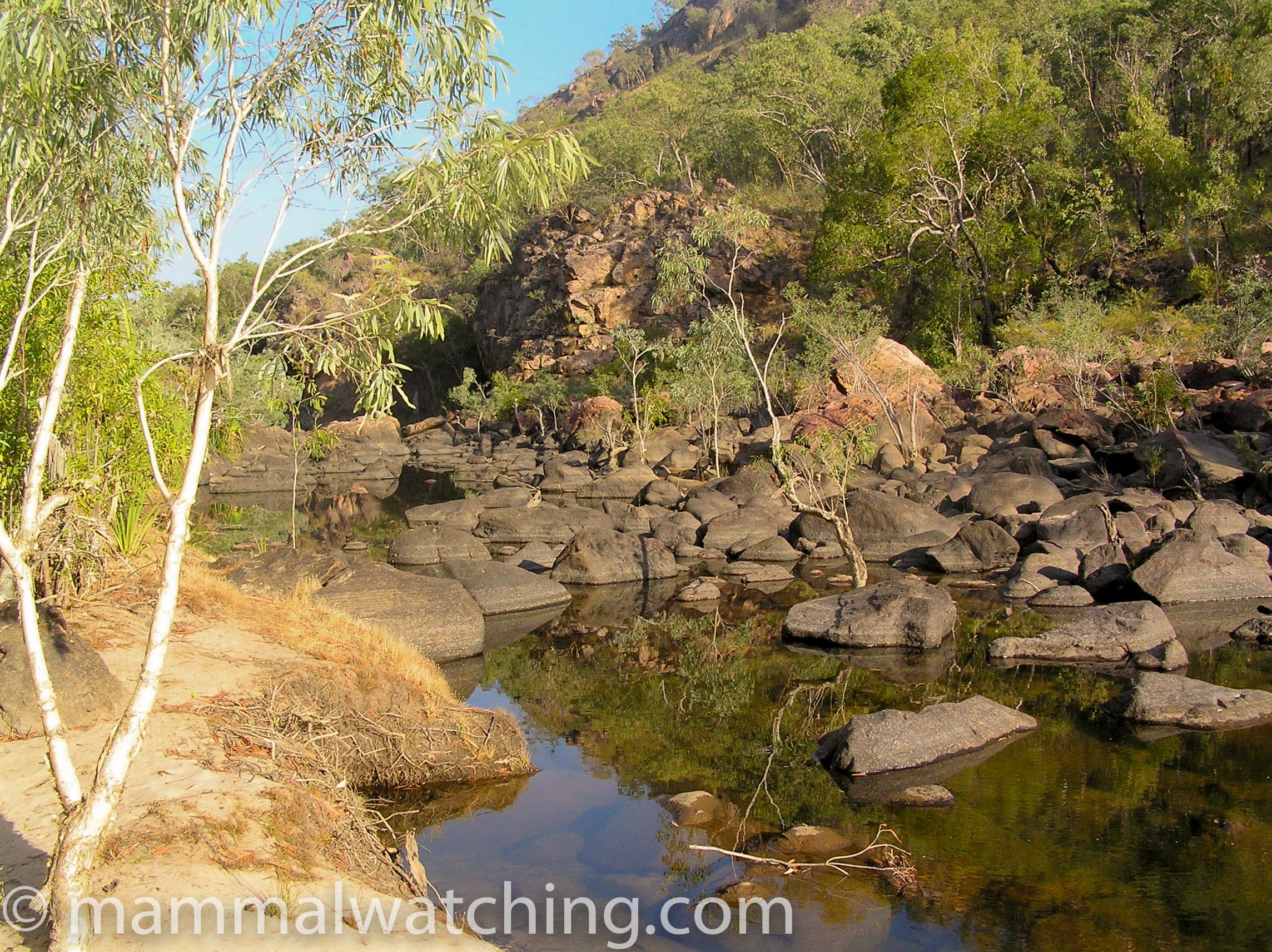
Koolpin Gorge, Kakadu
Kakadu has quite a long list of smaller mammals. Brush-tailed Rabbit Rats appear to have declined dramatically during recent years. Madrugal Campsite was the only reliable place I know to see this beautiful rodent. Madrugal is also reported to be home to Black-footed Tree Rats (another spectacular rodent). I have spot lit Fawn Antechinuses along the Gun Tree walk there. I also saw a Northern Brush-tailed Phascogale on the road outside (pre-toads).
Sandstone False Antchinus are endemic to the area and they can crop up anywhere with massive sandstone boulders and rock sheets. Nourlangie is one spot to look, and Koolpin Gorge is another (Koolpin is one of the nicest public campsites in Kakadu; you need to arrange a permit beforehand to stay there, which is easily done through the parks office). The road into Koolpin is one of the best areas of the park for Kakadu Pebble Mound Mice. I’ve looked but never seen them there – they live on the pebble strewn slopes on either side of the road in. They’ve also been reported from quite near Gunlom Campsite (a few kilometres before you get to Gunlom you cross Plum Tree Creek. Try looking around there).
In the south of the park – in appropriate habitat near Coronation Hill or El Sharana for example – you can find Pale Field Mice (Rattus tunneyi), Arnhem and Common Rock Rats and Western Chestnut Mice.
Kakadu Dunnarts are a species that has eluded me. I don’t know any reliable sites for them.
Kakadu has a long list of bats, but you’ll need a mist net or harp trap to see most of them. A few are findable unaided. There was a huge camp of Black Flying Foxes in the town of Jabiru when I was last there. I’ve seen Arnhem Roundleaf Bat (Hipposideros inornatus, a recent split for H. diadema) around the Gunlom Campsite. Their large size and striking colours mean they can be recognised in flight: I watched them landing on posts (possibly using them as hunting platforms) along the nature trail by the campsite. I’ve seen the occasional Troughton’s Sheathtail Bat inside caves and boulder piles during the night and day (try spotlighting around Nourlangie for example). And – so long as you get permission first of course – you can see Northern Cave Bats roosting under some of the Park staff houses at the Mary River Ranger Station. Yellow-bellied Sheathtail Bats have an audible echolocation call and can be picked out with a spotlight flying high and straight. Some of these might be Arnhem Sheathtail Bats (though I think the only way to reliably tell is with a shotgun!). Best of all though are the Ghost Bats, which have to be one of the world’s coolest chiropterans. You might run into these anywhere in the park, but there is a large roost outside the town of Pine Creek. The mine is now too dangerous to enter, and besides the bats are suffering from too much disturbance. But you could look for them around the outskirts of town at dusk. For the avoidance of doubt, Ghost Bats are a very large, white, false vampire bat. They eat reptiles, birds, small mammals and other bats. I suppose the Cane Toads may have had an impact on this species too, though the species has hung on in north Queensland.
Kakadu has its fair share of ferals. Massive wild Pigs are often seen from the Yellow Waters cruise. Brumbies (feral horses) are throughout the park and of course there are also Buffalo, though these are fewer in number than they once were. The Old Darwin Highway is one place to see them (if you keep an eye out for fresh buffalo poo along the road you can often track the animals down on foot by walking for a few minutes).
Litchfield National Park and Robyn Falls
Litchfield NP is quieter than Kakadu. It is a little less dramatic, but spectacular nonetheless, and has some good mammals. During a couple of days there in 2001 I saw Antilopine Wallaroos, Wikins’ (formerly Short-eared) Rock Wallabies (try looking around Florence Falls at dusk), a Northern Quoll (though the toads have now arrived here too so good luck), a Sugar Glider (near Tolmer Falls) and a Common Rock Rat while I was spotlighting around Florence Falls. One nice species that is probably easier to see here than anywhere else are the Orange Horseshoe Bats that roost around Tolmer Falls. Their roost site is closed to the public but if you wait with a spotlight at dusk above the plunge pool you will see them flying (their colour is quite distinctive).
Further south is Robyn Falls, a popular campsite next to the Stuart Highway. I’ve spent several hours here on various occasions looking for Nabarleks which live – or used to – on the cliffs here. I saw many small macropods: most were Short-eared Rock Wallabies; I doubt whether any were Nabarleks.
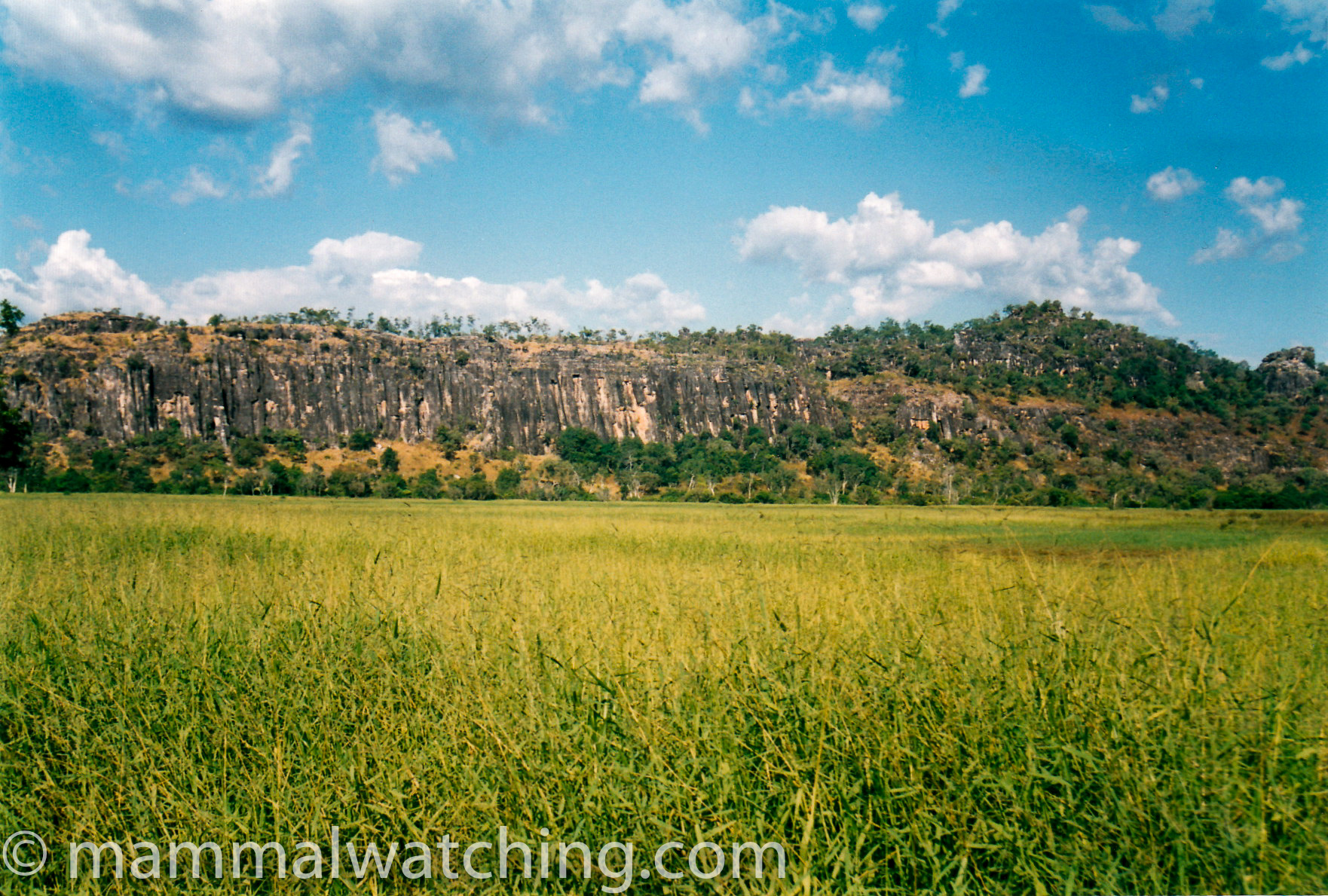
Arnhem Land
Arnhem Land
You need a permit to cross over the East Alligator river to enter Arnhem Land. It is Aboriginal Land and – based on 24 hours there – is one of my favourite bits of Australia. True, it is expensive to get there. But the money gets you a private Kakadu.
I went there for a night to stay at the Mt Borradaile Safari Camp in 2004. It’s a luxury safari-style camp, which by Australian standards is really very expensive. I drove in from Kakadu – several hours along a reasonable 4wd track. Most visitors arrive from Darwin via light aircraft. Back in the 1990s Mt Borradaile was an excellent place to see Nabarleks. Researchers reported them bouncing over their swags at night. But no longer. I saw what I think was one animal there after several hours searching over the mountain early in the morning (you might have more luck if you can persuade the operators to take you over there at night – but it involves a boat trip so they might be reluctant). But it is easy to confuse young Short-eared Rock Wallabies with Nabarleks and I am not sure that I did see a Nabarlek (had I done so it would have been one of the last sightings on mainland Australia). There were plenty of Wilkins’ (formerly Short-eared) Rock Wallabies, as well as a Black Wallaroo and – at night – a Rock Ringtail Possum and a Sandstone False Antechinus. Even without the animals the place is a great experience. Wandering alone through boulder piles, past the rock art, and burial sites strewn with human skulls and other bones is a memorable experience.
Some Other Top End Sites
I have not been to Gove, but it seems to be the place to go looking for Northern Hopping Mice, one of Australia’s hardest to find species. The Tiwi Islands are also reputed to be good for some species, including Butler’s Dunnart, known from only a few scattered records.
Wollogorang Station, on the border with Queensland is home to the only known population of Carpentarian Rock Rats. I’ve not been but imagine that the station owners will know the whereabouts of the colonies and that you’d have a decent chance of seeing an animal if you go out with a spotlight for a few hours.
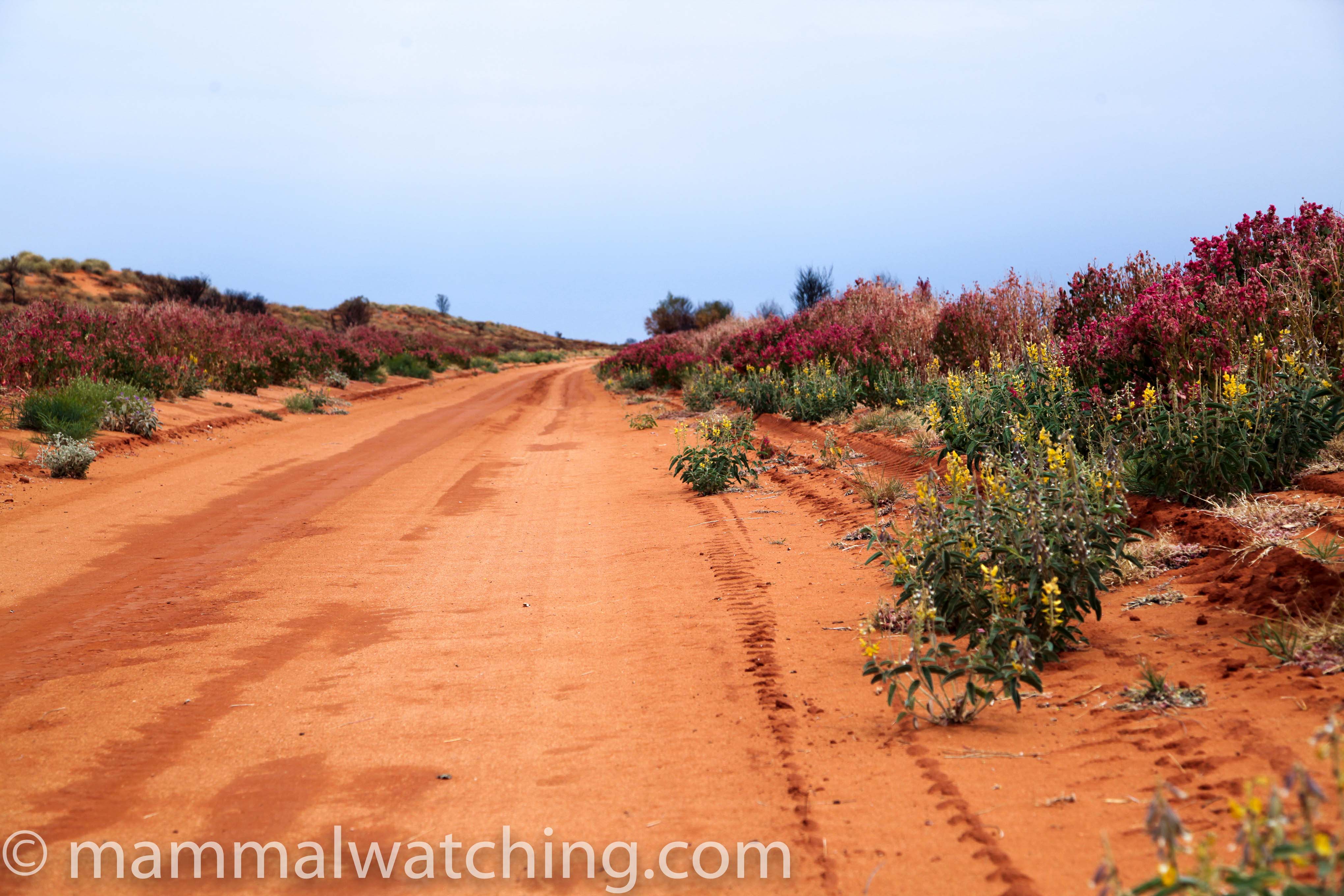
Binns Track: Alice Springs to Mt Dare
South and Central NT
In the desert country that comprises south and central NT the mammal watching is much less predictable. I spent a couple of weeks around Alice Springs in 2000 (when it flooded!), a week in 2005 travelling between Alice and the Devils Marbles (about 1000 km north), and a few days in 2011. The abundance of many species is linked with rainfall. Not only are animals more active – and so more visible – after rain, but many populations grow in numbers considerably after decent rain. My first two visits were badly timed from that point of view, whereas my 2011 trip was timed precisely because of the decent rains in 2010.
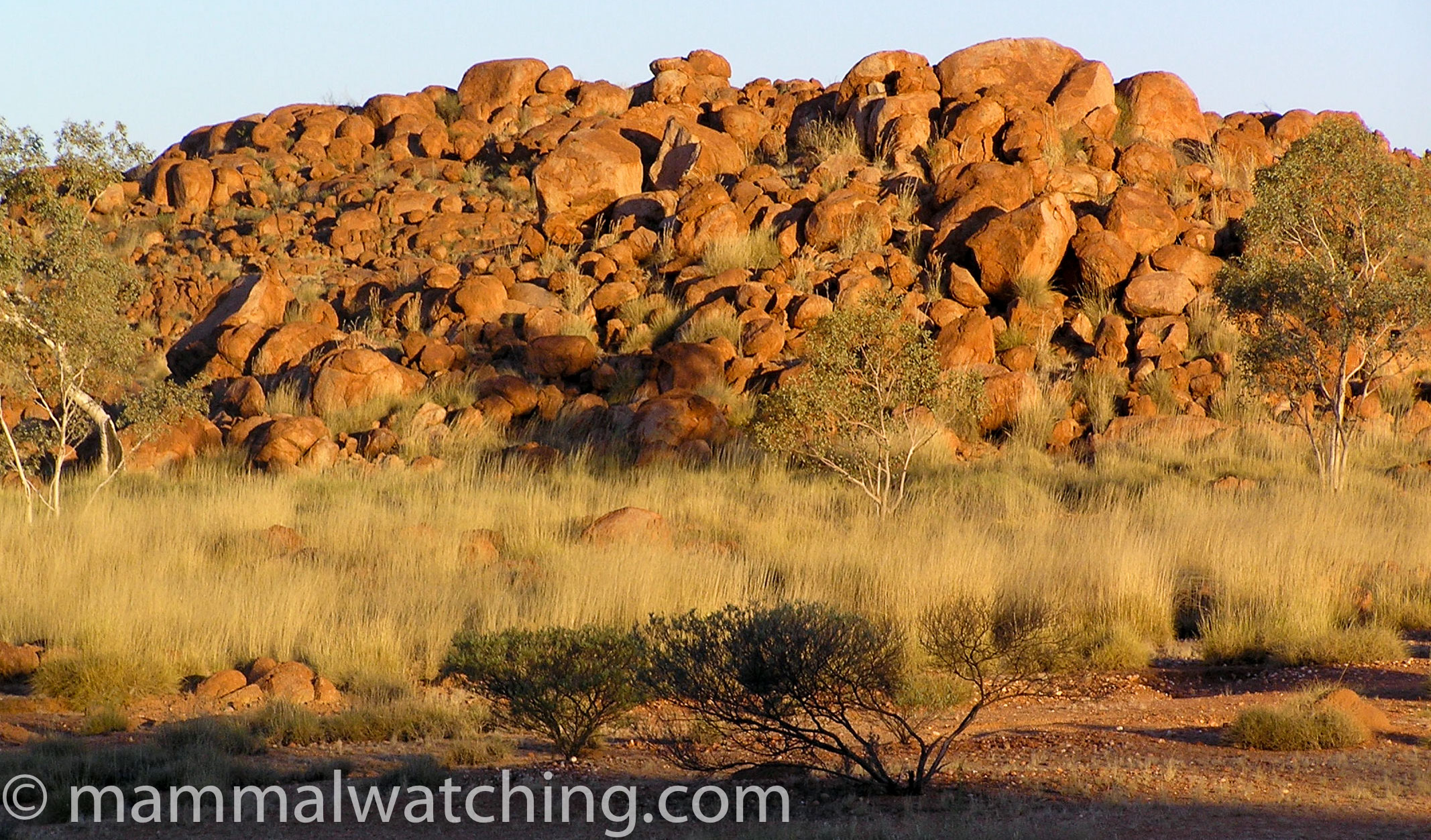
The Devil’s Marbles
Black-footed Rock Wallabies are pretty common around Alice Springs itself and throughout the Western McDonnell ranges. Try the hotel at Heavitree Gap in the city, where you can buy food to feed the wallabies. You can see this species in several other places around the Western Macs (e.g. Simpson’s Gap, Ormiston Gorge) as well as at the Devils Marbles, further north.
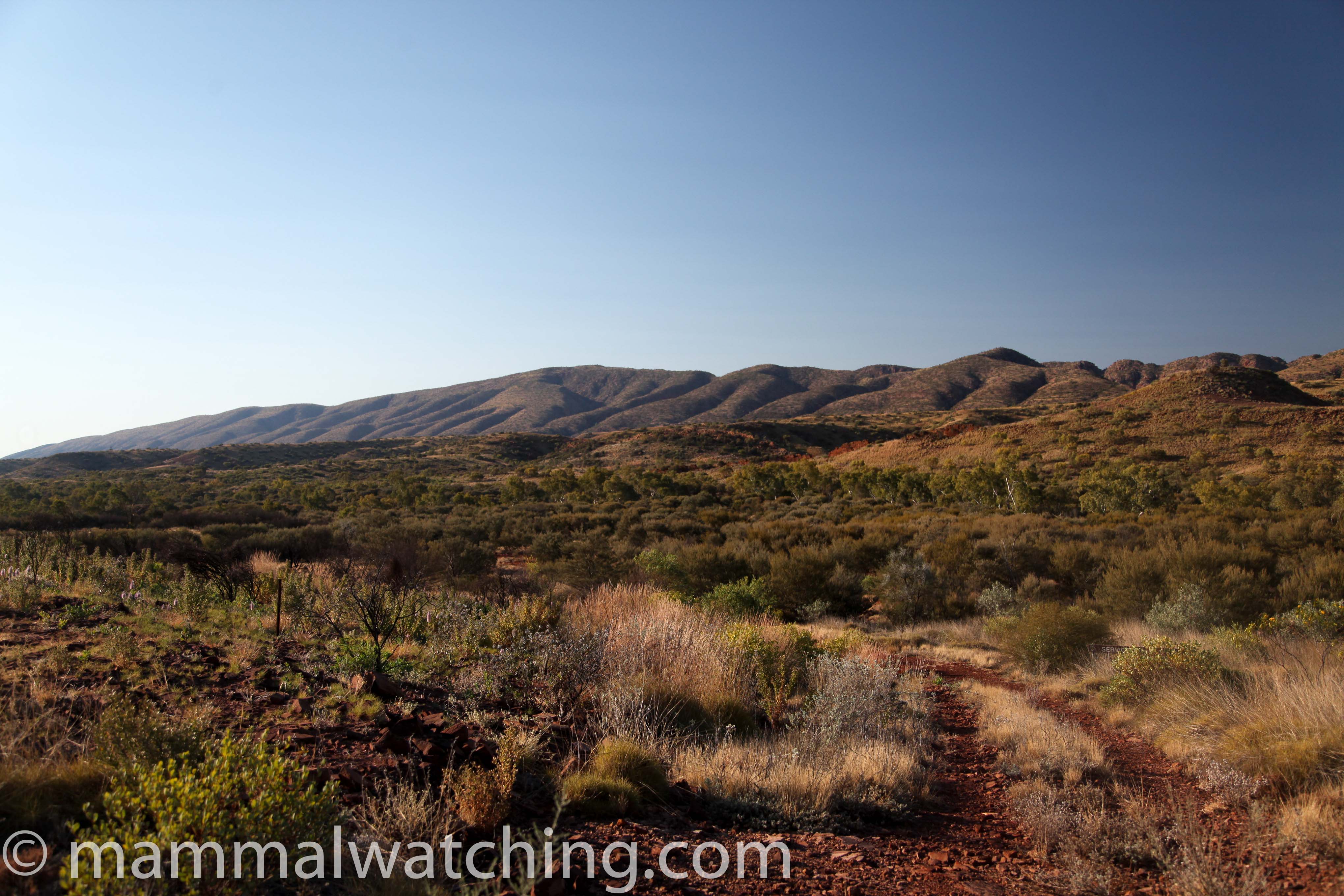
The Western McDonell Ranges
In 2005 biologists caught a Hairy-nosed Freetail Bat (a rare event) at the Alice Springs Desert Wildlife Park. The park – a sort of zoo/botanical garden – is well worth a visit in the daytime and they have a great nocturnal house.
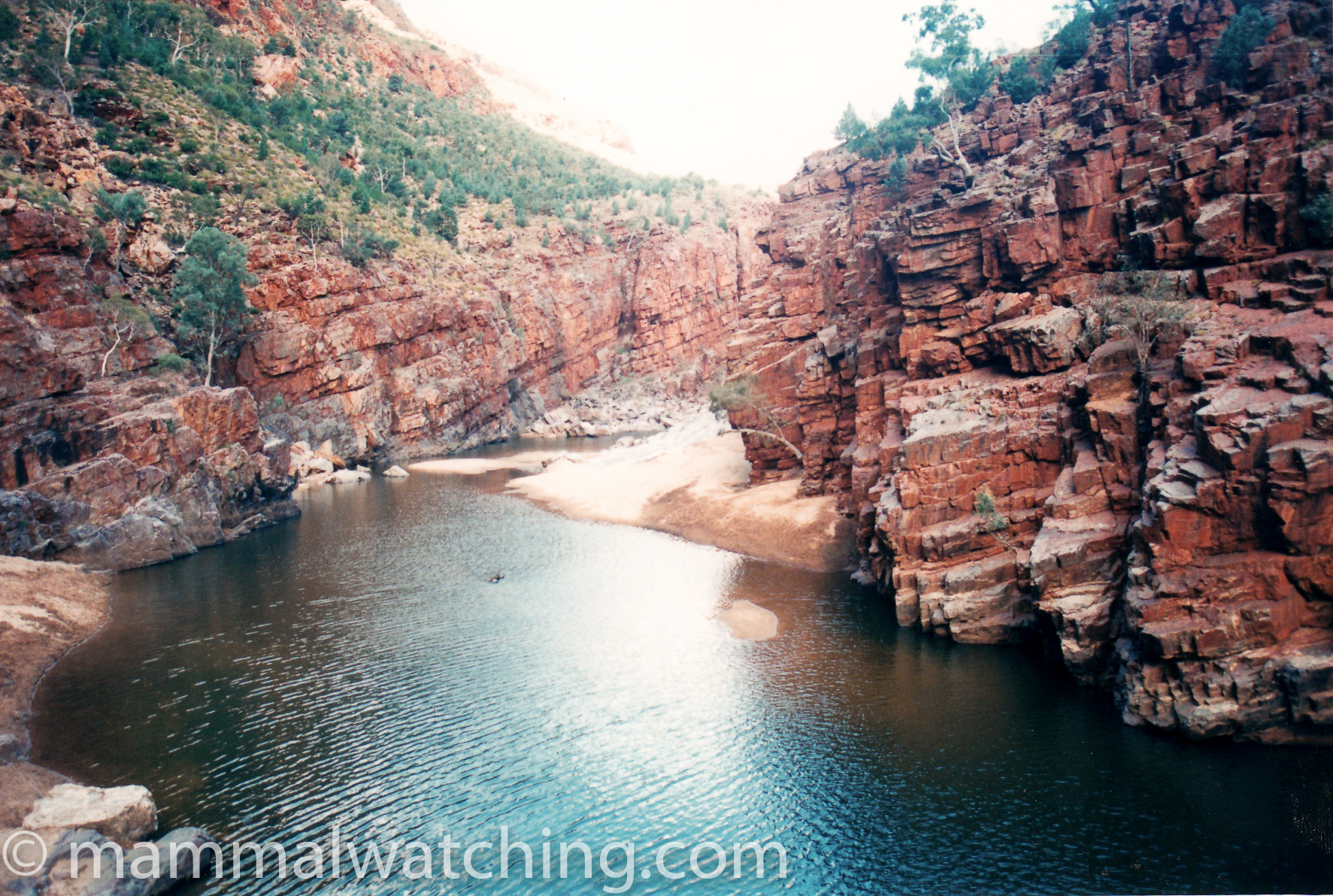
Ormiston Gorge
Central Rock Rats, long thought extinct, were rediscovered around Ormiston Gorge in the late 1990s. We looked for them there during an Australian Mammal Society expedition in 2000 but didn’t catch any. But we did catch some Fat Tailed Pseudantechinus in the scree slopes together with a single Desert Mouse (Pseudomys desertor). Dingos and Brumbies (feral horses) are not uncommon in this area either as are Black-footed Rock Wallabies. I don’t know when they last caught Rock Rats at Ormiston but I didn’t see any during a 2 hour spotlighting session in 2011. They were caught at the top of nearby Mount Sonder though in 2010 as was a very cool Long-tailed Dunnart.
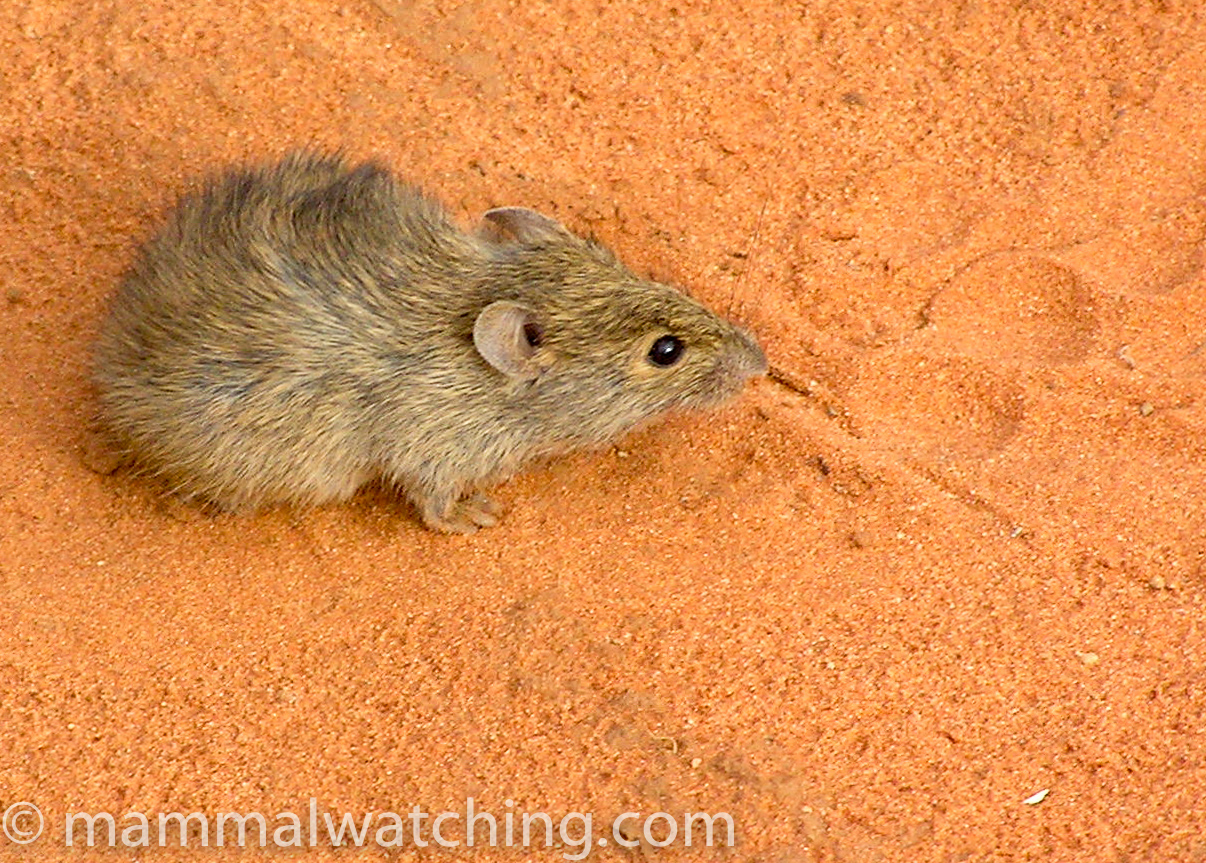
Desert Mouse, Pseudomys desertor
I have spent many hours spotlighting around Alice Springs but haven’t seen any mammals. But people occasionally bump into species like Kultarrs, Desert Mice or even Long-tailed Dunnarts. There is a bat cave in Alice Springs, easy to access and well known by the locals (it is south of town I think and near the railway line). It is home to Finlayson’s Cave Bats.
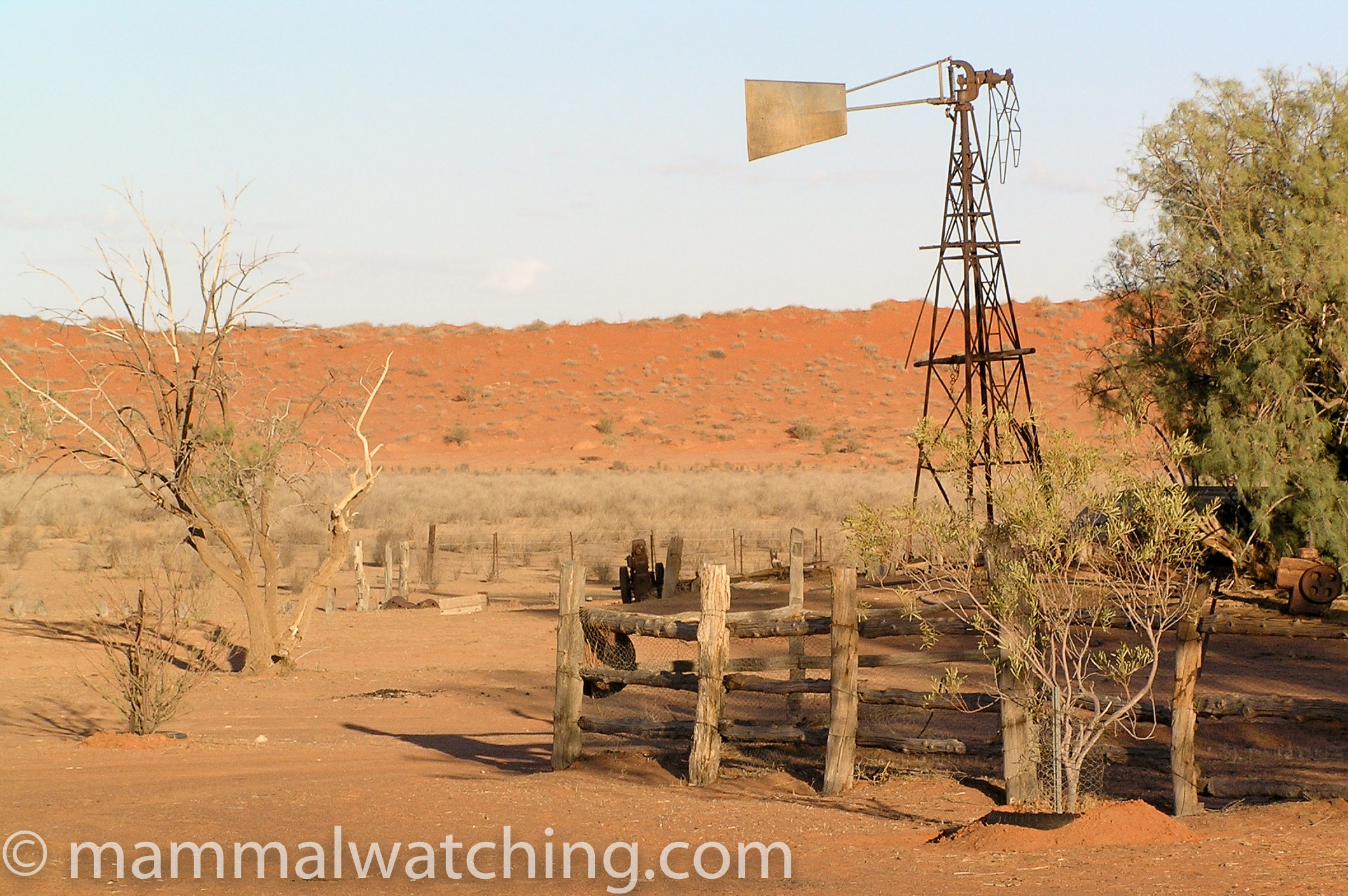
Old Andado Station, 2005
Old Andado Station, on the edge of the Simpson Desert, is a nice overnight trip from Alice. To get there you need to head from Santa Teresa along a 4 wd road that takes the best part of 6 hours. The country through there is glorious.
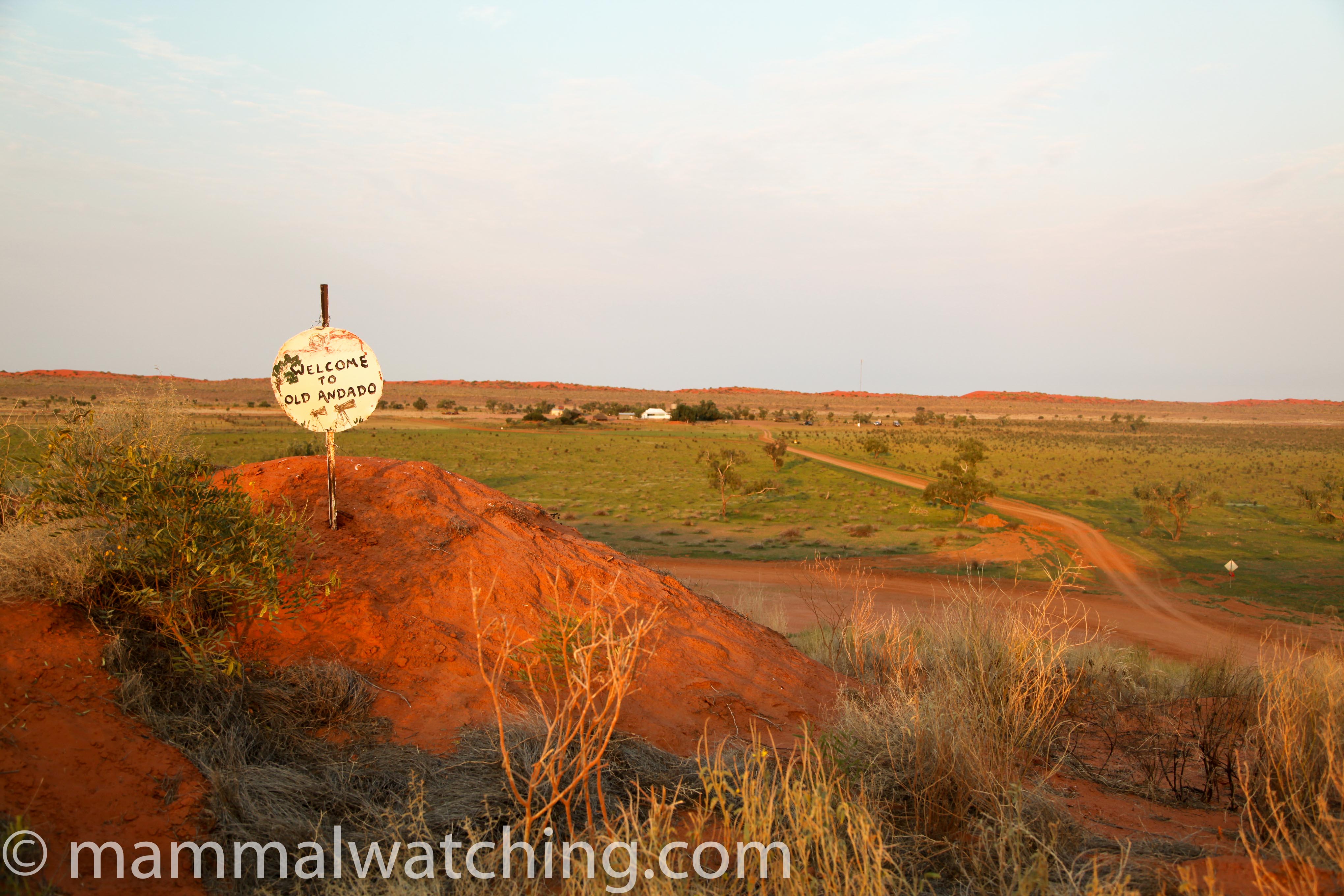
A much greener Old Andado, 2011
You should see Red Kangaroos and Wallaroos (Euros) as well as feral Horses . If your timing is right you have a good chance of seeing Plains Mice (Pseudomys australis) out near the Mac Clark Conservation Reserve. Numbers of Plains Rats plague after good rainfall. I didn’t see any the first time I visited in 2005, though they had still been around in good numbers a few months earlier (bird watchers often hear about rodent plagues because they attract raptors like Letter Wing Kites). I saw a small dunnart (probably Lesser Hairy-footed Dunnart ) when I was spotlighting around the present day Andado Station, where you can camp or stay the night in the homestead.
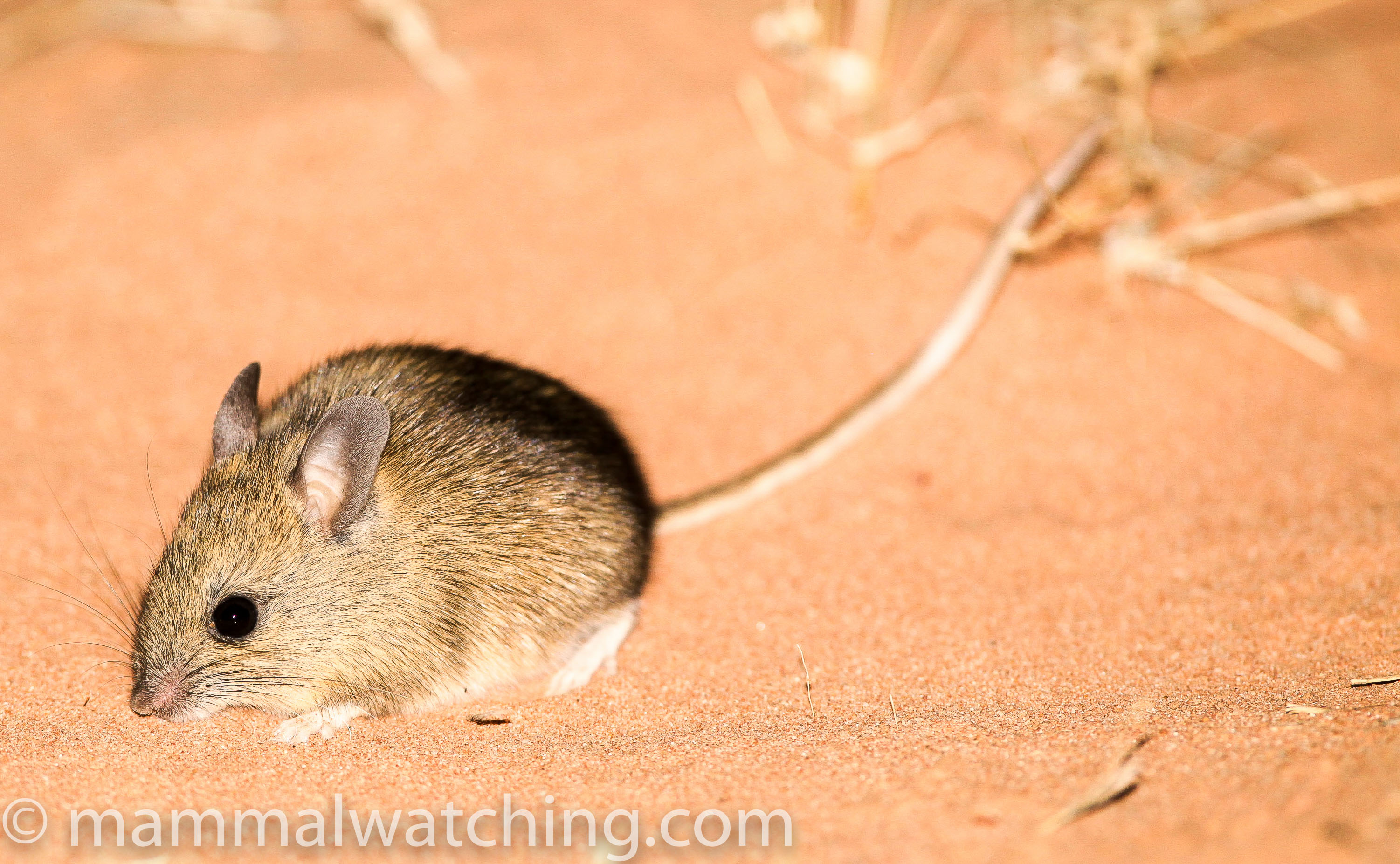
Plains Mouse, Pseudomys australis
In October 2011 I returned to see the large numbers of rodents that had irrupted after the heavy rains of 2010. I wasn’t disappointed. It was so much greener than when I was last there (see the pictures above). There were lots of Long-haired Rats running around, especially near Old Andado, and even more Plains Mice back along the road towards the Mac Clark reserve.
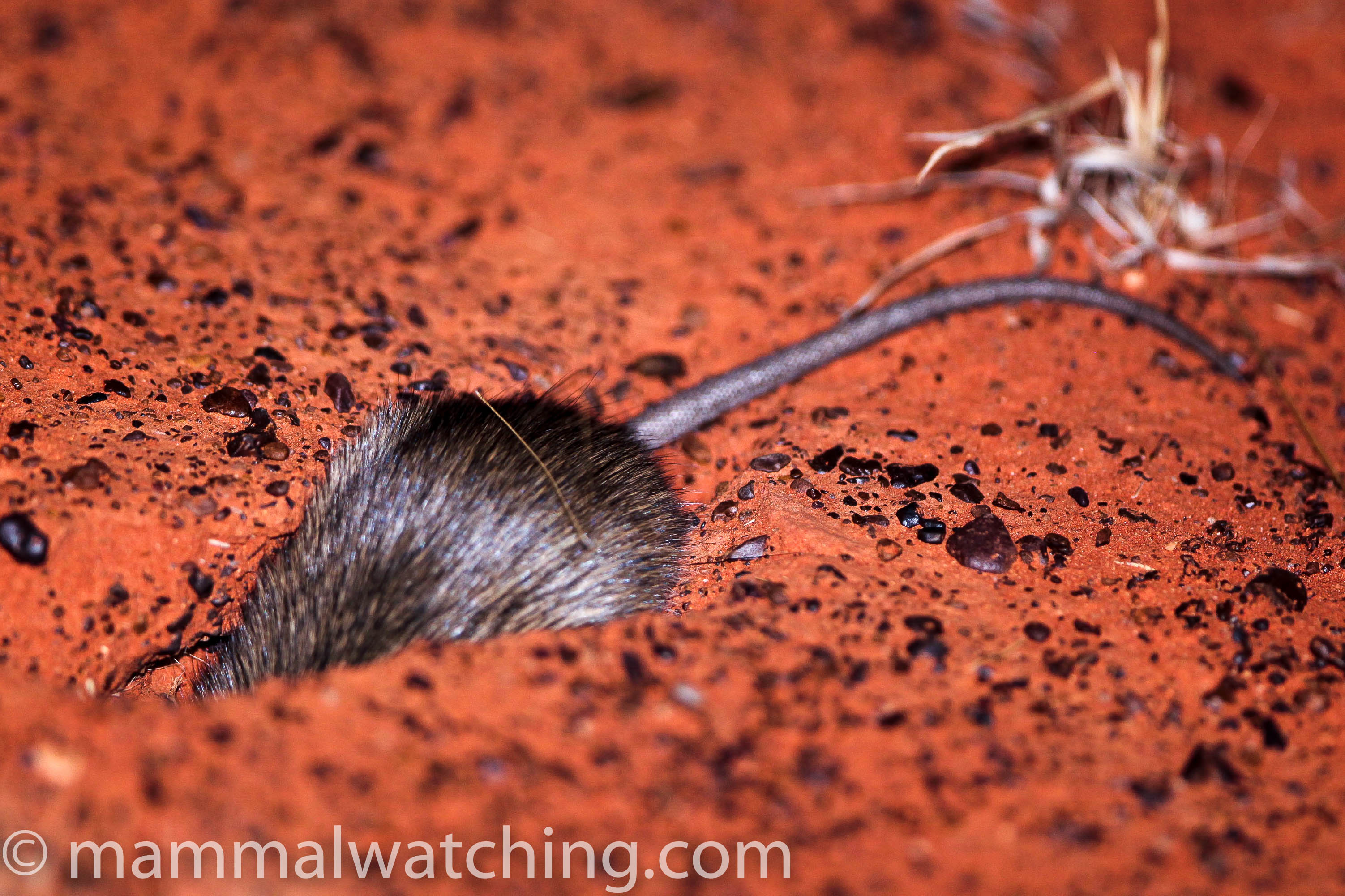
Long-haired Rat, Rattus villosissimus trying to hide
I saw at least one Kultarr (a lifer) about 20km from Old Andado towards Mac Clark, and plenty of Spinifex Hopping Mice, a few Sandy Inland Mice and several Dingos.
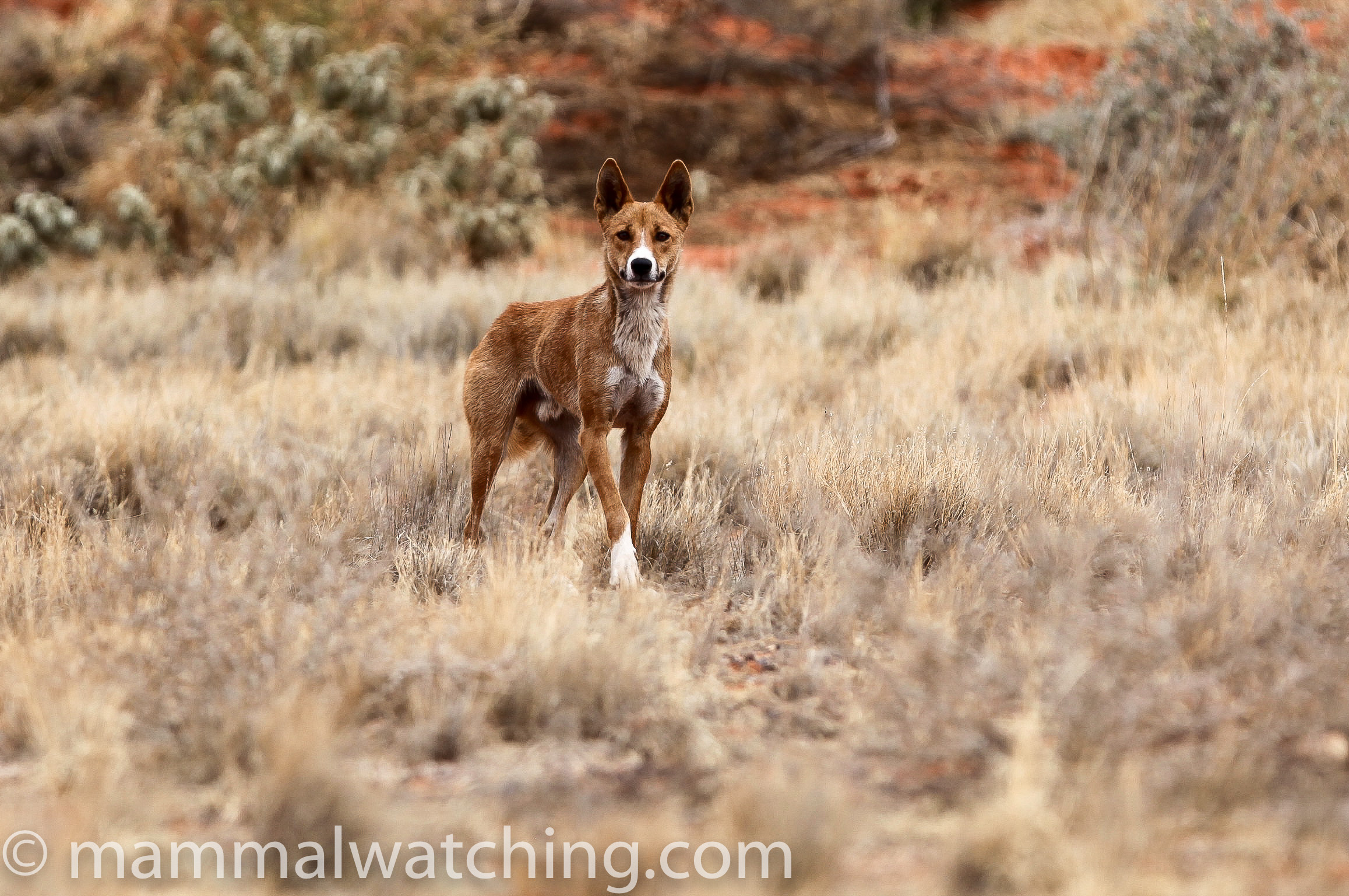
Dingo, Canis lupus dingo
I also found my first Letter-winged Kite – the world’s only nocturnal raptor and one I had long wanted to see.
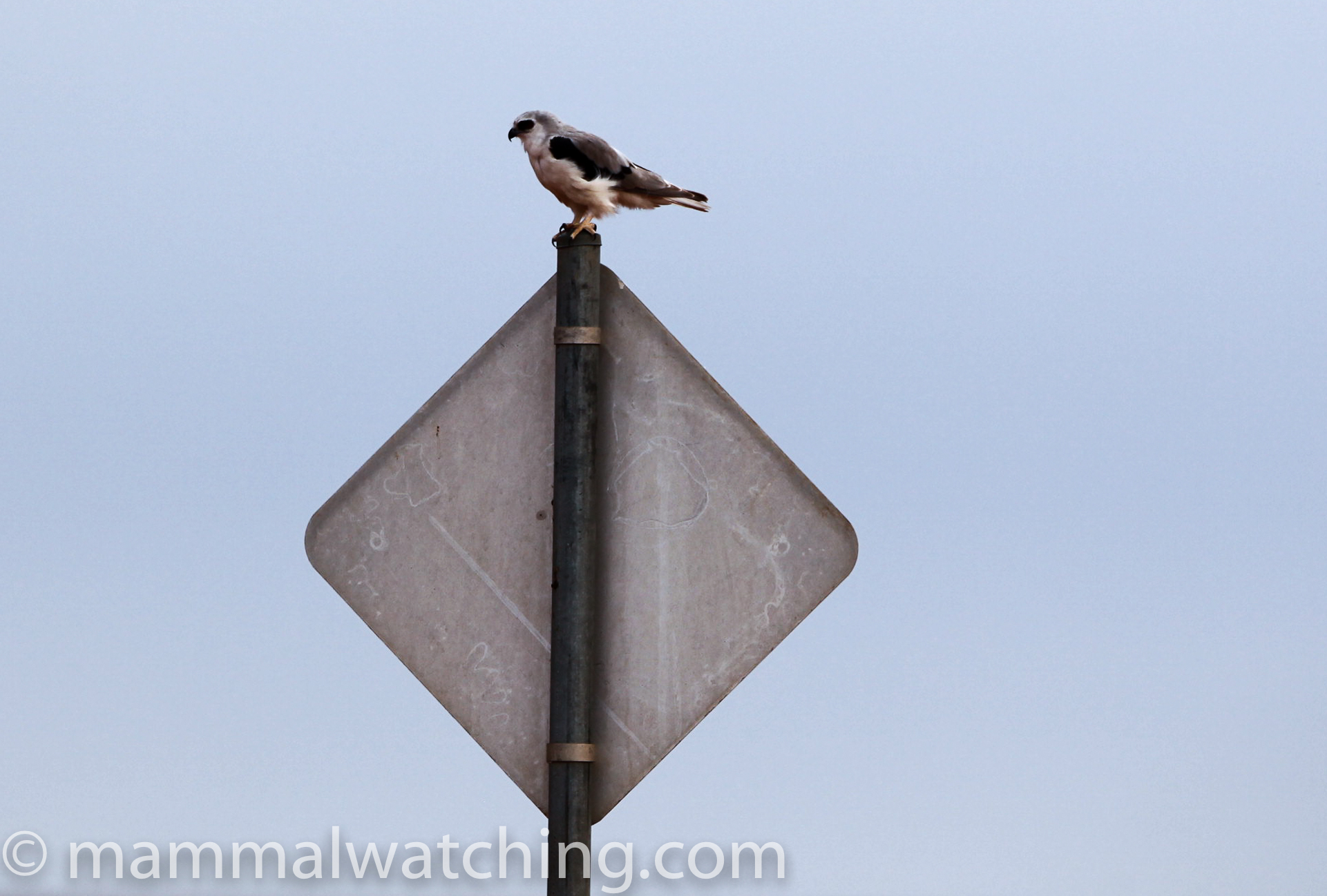
Letter-winged Kite
See my 2011 Trip Report for more information.
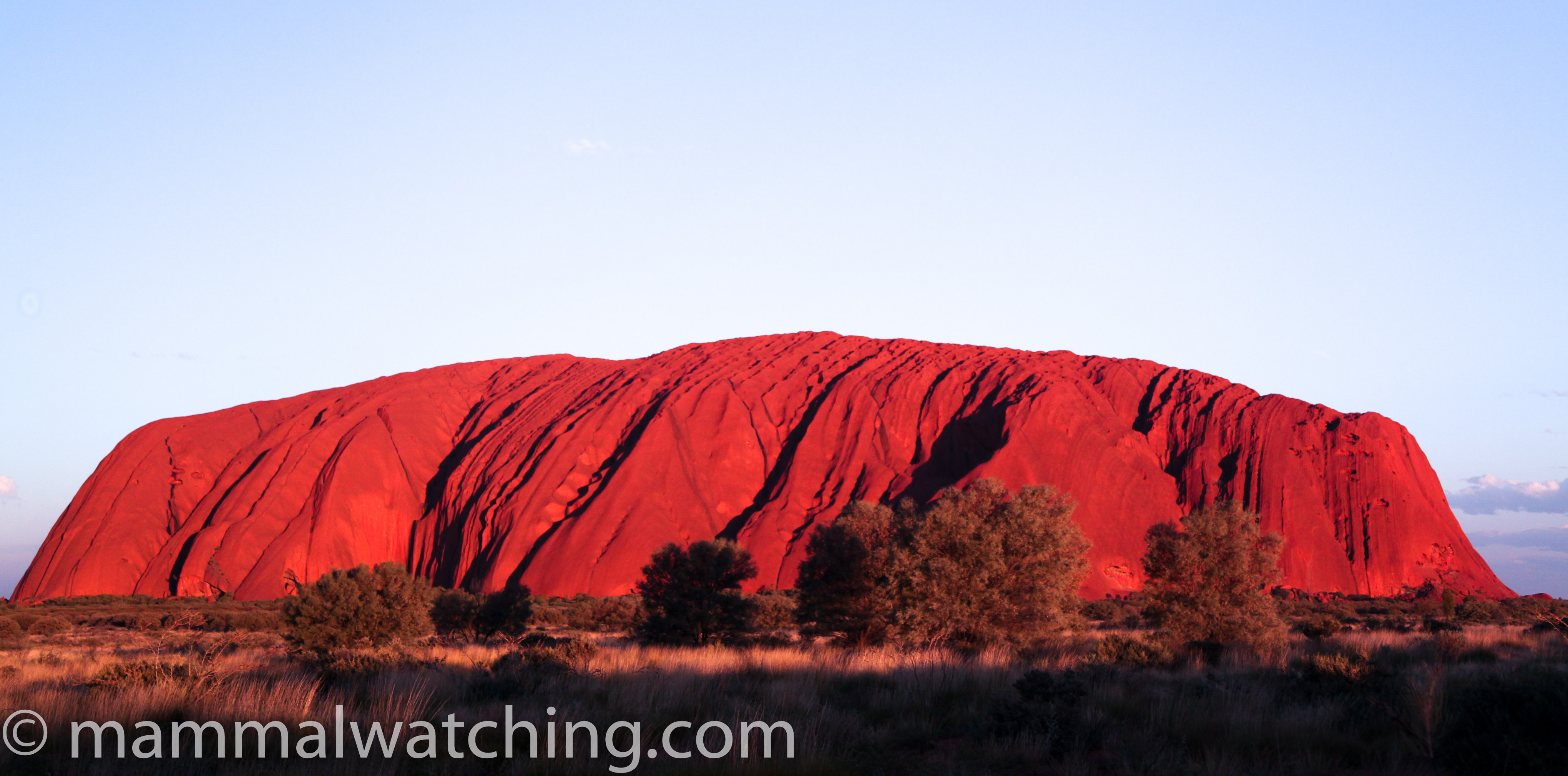
Uluru, April 2011
Uluru National Park (aka Ayers Rock) has a nice mammal list. They run surveys there every couple of years that I must try to get onto sometime. Species likely to be caught include Mulgaras, Kultarrs, Lesser Hairy-footed and Ooldea Dunnarts, Wongai Ningauis, Narrow-nosed Planigales, and Sandy Inland Mice.
You have as good a chance of seeing a Marsupial Mole around the Rock as you do anywhere. Moles are very seldom seen, but are supposed to come to the surface more often after heavy rain. Wandering around the Ulara resort at night, you should be able to see Spinifex Hopping Mice in the spotlight beam. Dingos are common in the campsite. You are not allowed to remain in the park itself more than one hour after sunset which is a great pity.
I visited in 2000, 2005 and again in 2011. In 2011, Spinifex Hopping Mice were very common around the dune trail after dark (the dune trail leads from the bus sunset viewing car park). This was also reputed to be a good spot for Mulgara but I looked in 2005 and again in 2011 and dipped (though as you need to leave by 8pm there isn’t a great deal of time to hunt for them).
There is not very much of anything between Alice Springs and Darwin and I suppose you have an equally good or bad chance of seeing things anywhere. I haven’t had much luck.
Community Reports
NT, WA, SA, NSW & Vic, 2019: Isaac Clarey’s mega report, 5 months & 89 species including Scaly-tailed Possum (WA), Rock Ringtail Possum (NT), Monjon (WA), Ghost Bat (NT & WA) and Orange Leaf-nosed Bat (NT), Fawn Antechinus (NT), Southern Greater Gliders (NSW) and Yellow-bellied Gliders (NSW) and much more.
Australia, 2018: Valentin Moser’s report of mammals seen over the course of 75 days on several trips. He saw over 100 mammals including Mahogany Glider, both Feathertail Gliders, Proserpine Rock Wallaby, Numbat and Honey Possum.
Central Australia, 2017: Tim Bawden, 1 week & 19 species including Kultarr, Plains, Bolam’s and Desert Short-tailed Mouse.
Australia, 2016: Domique Brugiere, 2 months and a lot of mammals including Black Wallaroos, Rothschild’s, Cape York, Godman’s, Sharman’s and Proserpine Rock Wallabies plus Bridled Nailtail Wallabies
Australia and New Zealand, 2014/15: Pieter de Groot Boersma, 10 months & 117 species including Brush-tailed Rabbit Rat, Feathertail Glider, Leadbeater’s Possum, Northern Bettong, Prehensile Tailed Rat and Cape York Rock Wallaby. <<Note: in the Northern Territory, the Nailtail Wallaby was in fact Northern, not Bridled. And expert opinion think the mysterious macropod discussed at the end of the report was a Short-eared Rock Wallaby not a Narbalek.>> Click here to search for Pieter’s various videos from Australia.
Northern Australia, 2012: Dion Hobcraft, 18 days, 7500km & an impressive 43 species including some difficult ones like Kultarr, Scaly-tailed Possum, Northern Leafnosed Bat and Northern Dibbler.
Northern Territory, Australia 2011: Jon Hall, 5 nights and 12 species including a Kultarr, Long-haired Rats, Plains Mice and a Desert Short-tailed Mouse.
Australia and New Zealand, 2011: Matt and Maureen Steer, 12 weeks & 50 species including Spinifex Hopping Mice in the NT.
Western Australia, Alice Springs & Tasmania (2008): Don Roberson, 2 weeks and 18 mammals.
Australia, 2004: Richard Webb, 1 month & an impressive 50 mammals.
Also See
RFI Mega Trip to Australia, September 2024
Interesting post on how to find Bilbies (Nov, 2015), Twitching Diaries, Bruce Greatwich.
Resources
Cole, J. and Woinarski, J. 2002. A Field Guide to the Rodents and Dasyurids of the Northern Territory. Surrey Beatty & Sons. Some very useful information on both where to look and how to identify some of the hardest species to find in Australia.


Leave a Reply
You must be logged in to post a comment.